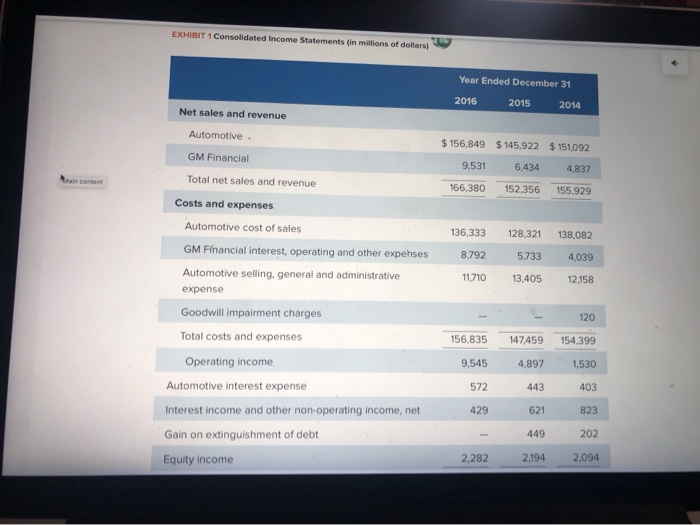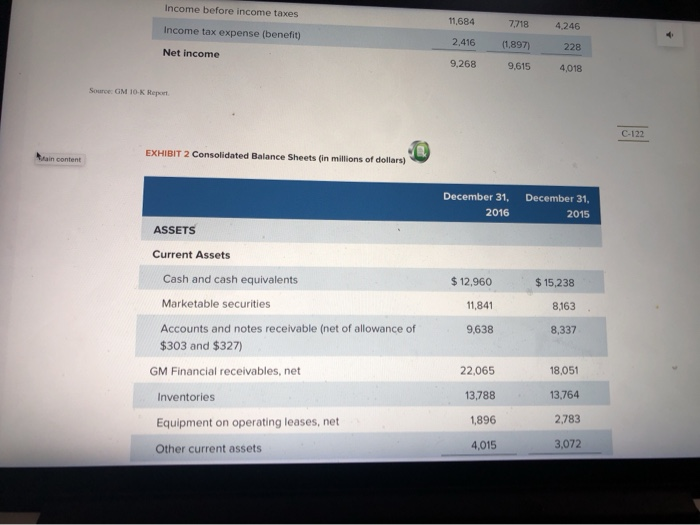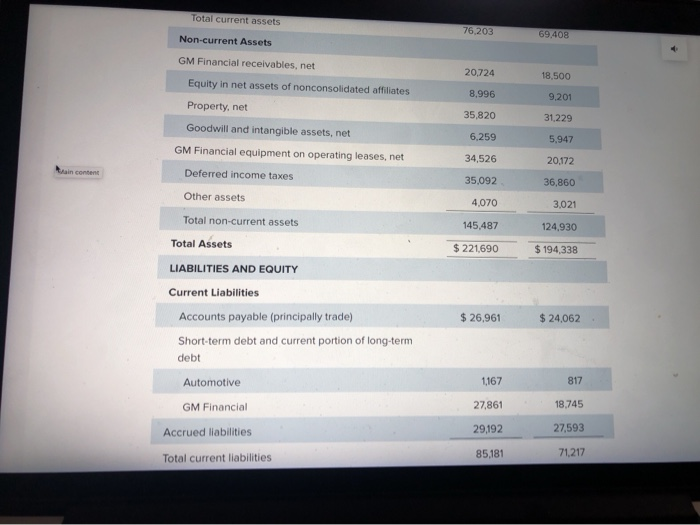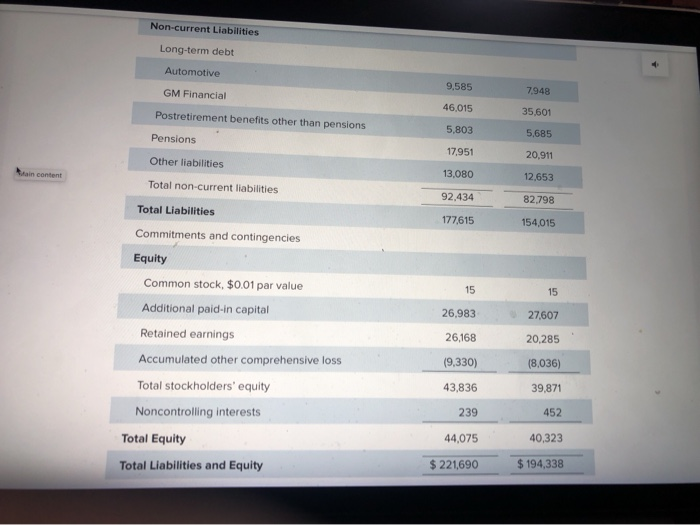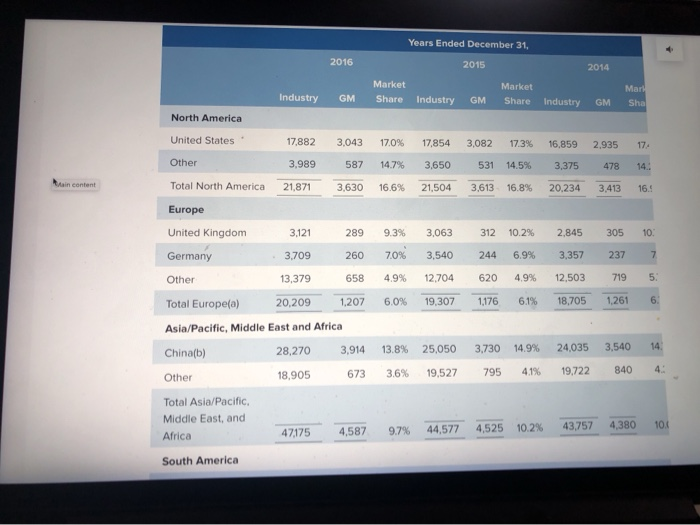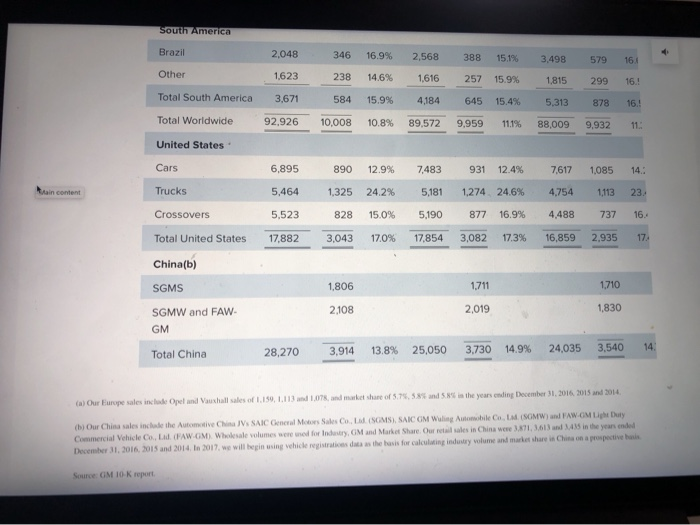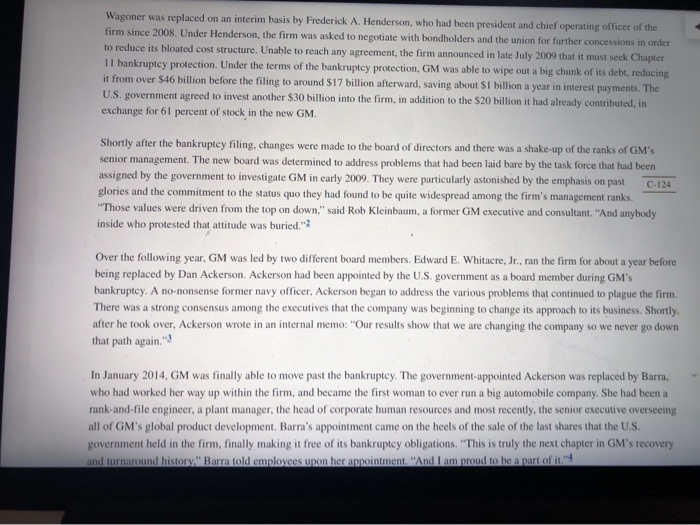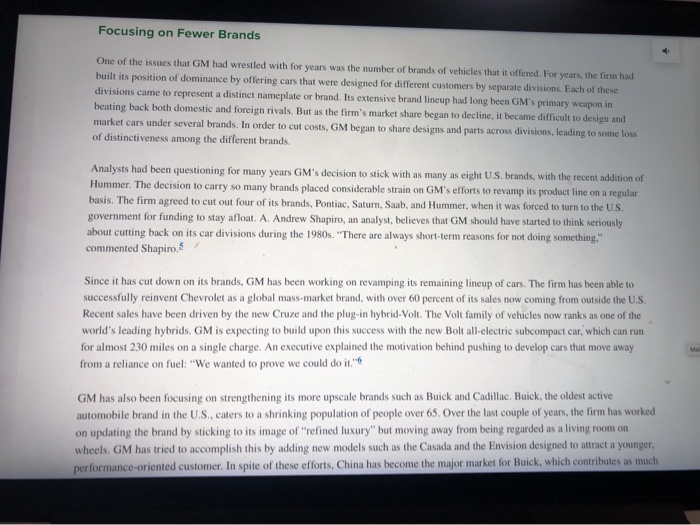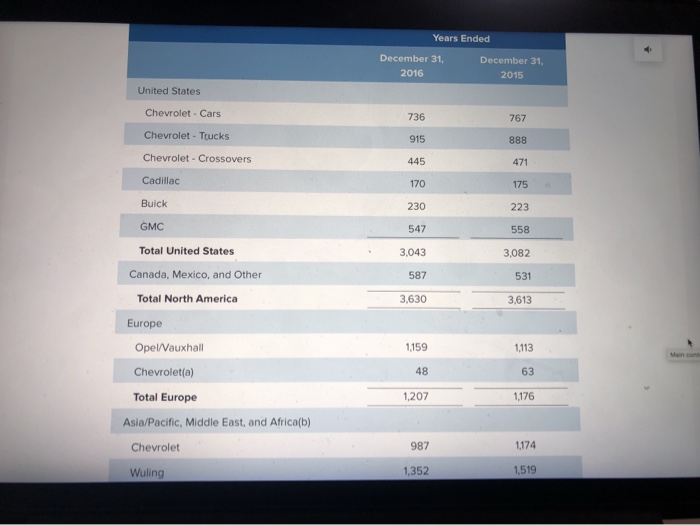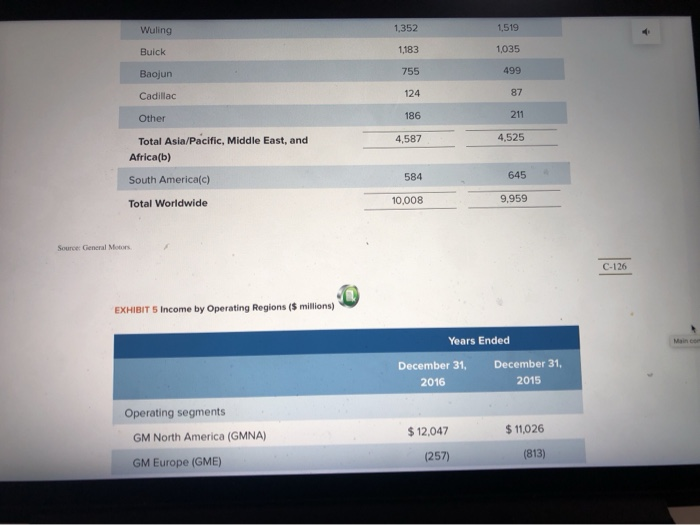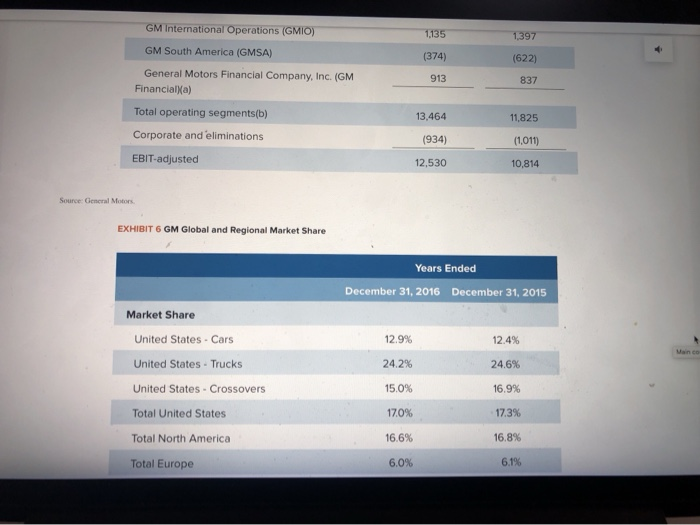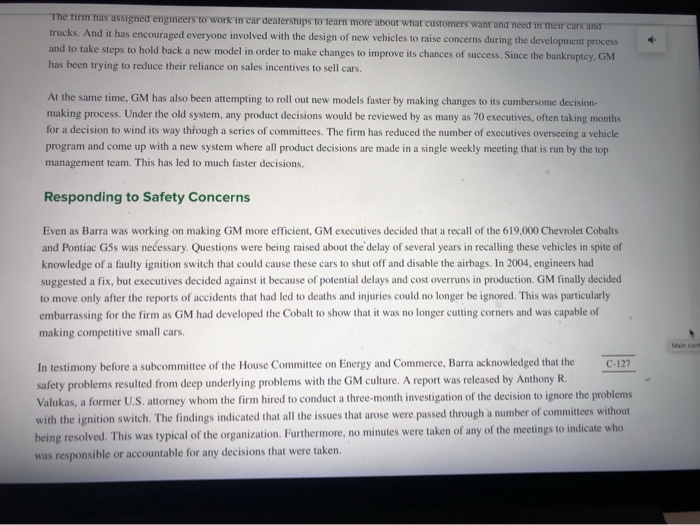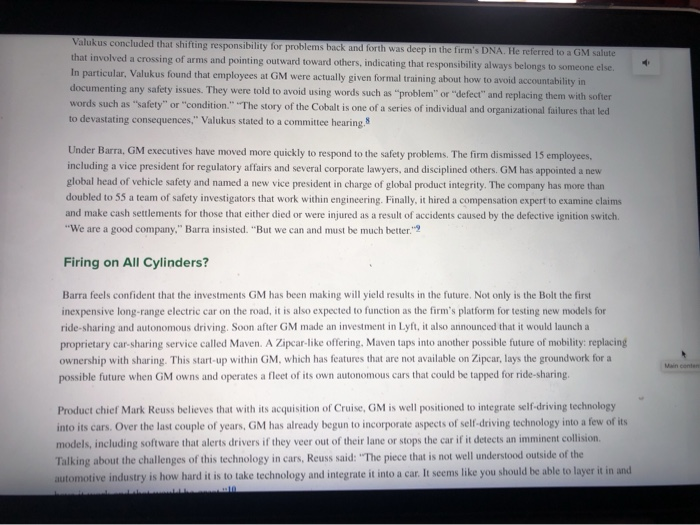CASE 18 C-120 GENERAL MOTORS IN 2017* Main content on February 14, 2017, Mary T. Barra, the CEO of General Motors, floated the possibility that the company could exit the large but troubled European market by selling its chronically unprofitable Opel unit to the French maker of Peugeot and Citroen cars. The sale would free the firm from persistent losses in Europe and fulfill pledges by Barra to improve overall profit margins and increase returns to shareholders. Shedding Opel would reduce GM's volume by 10 percent and knock the leading U.S. automaker out of the chase to be the top seller globally, a spot it had owned until recently. Under Barra, the firm had been dismantling unprofitable operations, which included abandoning Russia and certain Asian markets. Industry analysts expected that Barra, who had worked for GM her entire career, would let the firm relapse into the arrogance, complacency, and denial that plunged it into bankruptcy in 2009. Soon after she assumed the helm of GM in January 2014, Barra had to deal with a devastating ignition switch flaw that was tied to 139 deaths and that eventually resulted in $2.1 billion in fines. lawsuit settlements, and recall costs. Barra has managed to avoid any significant effect on the firm's reputation from the bankruptcy and the safety issues. Over the past three years, GM has shown considerable growth in its net income, although its stock has been stuck below the IPO price of S33 per share of 2010 (see Exhibits 1 to 3 ). C-121 EXHIBIT 1 Consolidated Income Statements (in millions of dollars) EXHIBIT 1 Consolidated Income Statements in millions of dollars) Year Ended December 31 2016 2015 2014 Net sales and revenue Automotive GM Financial $ 156,849 9,531 166,380 $ 145,922 $ 151092 6,434 4,837 152,356 155,929 train content Total net sales and revenue Costs and expenses Automotive cost of sales 128,321 138,082 GM Financial interest, operating and other expenses 136,333 8,792 11,710 Automotive selling, general and administrative expense 5733 13.405 4,039 12,158 Goodwill impairment charges 120 Total costs and expenses 147,459 154,399 Operating income 156,835 9,545 572 429 Automotive interest expense 4,897 443 621 449 1530 403 823 Interest income and other non-operating income, net Gain on extinguishment of debt - 202 Equity income 2,282 2,194 2,094 Income before income taxes 11.684 7718 Income tax expense (benefit) 4246 2,416 Net Income (1.897) 9.615 228 4,018 9,268 Source: GM 10- Report C-122 EXHIBIT 2 Consolidated Balance Sheets (in millions of dollars) December 31, 2016 December 31, 2015 ASSETS Current Assets Cash and cash equivalents $ 15,238 $ 12,960 11,841 Marketable securities 8,163 9,638 8,337 Accounts and notes receivable (net of allowance of $303 and $327) GM Financial receivables, net 22,065 18,051 Inventories 13,788 13,764 Equipment on operating leases, net 1,896 2,783 20062 783 Other current assets 4,015 3,072 Total current assets 76,203 Non-current Assets 69.408 GM Financial receivables, net 20,724 Equity in net assets of nonconsolidated affiliates 8,996 18,500 9.201 31.229 Property, net 35,820 Goodwill and intangible assets, net GM Financial equipment on operating leases, net 6,259 5,947 20,172 Deferred income taxes 34,526 35,092 36,860 Other assets 4,070 3,021 Total non-current assets 145,487 Total Assets 124.930 $ 194,338 $ 221,690 LIABILITIES AND EQUITY Current Liabilities Accounts payable (principally trade) $ 26,961 $ 24,062 Short-term debt and current portion of long-term debt Automotive 817 1,167 27,861 GM Financial 18,745 Accrued liabilities 27,593 29,192 85,181 71,217 Total current liabilities Non-current Liabilities Long-term debt Automotive 9,585 GM Financial 7,948 46.015 Postretirement benefits other than pensions 35,601 5,803 Pensions 5,685 17,951 20,911 Other liabilities Hain content 12,653 Total non-current liabilities 13,080 92.434 82.798 Total Liabilities 177,615 154,015 Commitments and contingencies Equity Common stock, $0.01 par value Additional paid-in capital 26,983 27,607 Retained earnings 26,168 20,285 Accumulated other comprehensive loss (9,330) (8,036) Total stockholders' equity 43,836 39,871 Noncontrolling interests 239 452 Total Equity 44,075 40,323 Total Liabilities and Equity $ 221,690 $ 194,338 Years Ended December 31, 2016 2015 2014 Market Industry w Market Industry GM S hare Industry GM Share Industry GM Mark She North America United States Other 17,882 3,989 21,871 3,043 587 3,630 17.0% 14.7% 16.6% 17,854 3,650 21,504 3,082 531 3.613 17.3% 14.5% 16.8% 16,859 3,375 20,234 2,935 478 3.413 17 14.: 16.5 Total North America Europe United Kingdom Germany 3,121 3,709 13,379 20,209 2899.3% 260 7.0% 658 4.9% ,207 6.0% 3,063 3,540 12,704 19,307 312 244 620 1,176 10.2% 6.9% 4,9% 61% 2,845 3,357 12,503 18,705 305 237 719 1,261 10: 7 5: 6: Other Total Europe(a) 1 Asia/Pacific, Middle East and Africa Chinab) 28,270 3,914 Other 18,905 673 13.8% 3.6% 25,050 19,527 3,730 795 14.9% 41% 24,035 19,722 3,540 840 14 4: Total Asia/Pacific Middle East, and Africa 4,587 9.7% 47175 44,577 4,525 10.2% 43,757 4,380 104 South America South America Brazil Other 2,048 1,623 3,671 92,926 346 238 584 10,008 16.9% 14.6% 15.9% 10.8% 2,568 1,616 4,184 89,572 388 257 645 9,959 Total South America Total Worldwide 15.1% 15.9% 15,4% 111% 3,498 1,815 5,313 88,009 579 299 878 9,932 164 16.! 16.! 11: United States Cars Trucks 6,895 5,464 5,523 17,882 890 1,325 828 3,043 12.9% 24.2% 15.0% 17.0% 7,483 5,181 5,190 17,854 931 1,274 877 3,082 12.4% 24.6% 16.9% 17.3% 7,617 4,754 4,488 16,859 1,085 1,113 737 2,935 14.: 23. 16, 17 Crossovers Total United States China(b) SGMS - 1,806 2,108 1,711 2,019 1.710 1,830 SGMW and FAW. GM Total China 28,270 3,914 13.8% 25,050 3,730 14.9% 24,035 3,540 141 1 .078.and market share of 5. 58 and (a) Our Europe sales include Opel and Vauxhall sales of 1.159, . 1 is the years anding December 31, 2016 2015 and 2014 ch) Our China sales include the Automotive Chi Vs SAIC General Motors Sales Co. (SOMS, SAICOM Wuling Automobile Co. M SGMW) FAW.GM Light Duty Commercial Vehicle Co, La (FAW.GM) Wholesale volumes were med for industry, GM and Market Share Our retail sales in China were 3.871.3.613 in the years ended December 31, 2016, 2015 and 2014. In 2017, we will begin using vehicle registrative data as the basis for calculating industry wolume and market share in China on a prospectives Source GM 10-K report Barra has been preparing GM to be a formidable player in the future. She has pushed the firm to be more involved in new developments, such as electric vehicles, ride sharing, and driverless cars. When the firm launched its first h eld at the Volti 2010, it was significantly laging behind all other competitors in terms of investing into emerging technologies. Nevertheless. Barra claims that it was an important first step in acknowledging where GM needed to go Since then, GM has launched the new all-electric Bolt, which promises an almost 240-mile range between charges for a price of $30,000 after federal tax credits. It has moved quickly to beat Tesla's new budget-priced Model 3 to market. In January 2016. GM announced a 5500 million investment in Lyn, the country's second largest ride-share service. It has subsequently worked with Lyft to develop a program which allows Lyft drivers in seven big cities to rent GM cars at a discount. The firm has acquired Cruise Automation which has built a complex array of software and hardware that uses artificial intelligence to pilot a car. By making these moves, GM is constructing a portfolio of assets that are dedicated to disrupting its own core business from within. Barra is keenly aware that GM's 223,000 employees will have to behave differently for its future plans to succeed. She must replace a culture of blame and bureaucracy with one driven by accountability and speed. "In this area of rapid transformation, you have to have a culture that's agile," she said. "We still have a lot of work to do." Moving through Bankruptcy GM has fallen from its dominant position when it held almost 50 percent of the U.S. market for automobiles. A succession of CEOs over the years failed to halt its decline in spite of their resolve to turn things around. When Richard Wagoner took over in 2000, he carried out three major restructurings, eliminating dozens of plants, tons of thousands of jobs, and jettisoning hundreds of dealers. In spite of these efforts, GM announced a loss of $30.9 billion dollars for 2008, amounting to a staggering 550 a share. The firm had not managed to post a profit since 2004, running up cumulative losses of over $82 billion between 2005 and 2009 Wagoner eventually began to run short of funds and turned to the US government for loans in order to survive. The Obama administration demanded his resignation for its support. Wagoner was replaced on an interim basis by Frederick A. Henderson, who had been president and chief operating officer of the firm since 2008. Under Henderson the frames asked to maintawwith handheldssandithammion for the concesions.in.nl Wagoner was replaced on an interim basis by Frederick A. Henderson, who had been president and chief operating officer of the firm since 2008. Under Henderson, the firm was asked to negotiate with bondholders and the union for further concessions in ordet to reduce its bloated cost structure. Unable to reach any agreement, the firm announced in late July 2009 that it must seek Chapter 11 bankruptcy protection. Under the terms of the bankruptcy protection, GM was able to wipe out a big chunk of its debt, reducing it from over 516 billion before the filing to around 517 billion afterward, saving about Si billion a year in interest payments. The U.S. government agreed to invest another $30 billion into the firm, in addition to the S20 billion it had already contributed in exchange for 61 percent of stock in the new GM. Shortly after the bankruptcy filing, changes were made to the board of directors and there was a shake-up of the ranks of GM's senior management. The new board was determined to address problems that had been laid bare by the task force that had been assigned by the government to investigate GM in early 2009. They were particularly astonished by the emphasis on past C-124 glories and the commitment to the status quo they had found to be quite widespread among the firm's management ranks. "Those values were driven from the top on down," said Rob Kleinbaum, a former GM executive and consultant. "And anybody inside who protested that attitude was buried." Over the following year, GM was led by two different board members. Edward E. Whitacre, Jr, ran the firm for about a year before being replaced by Dan Ackerson. Ackerson had been appointed by the U.S. government as a board member during GM's bankruptcy. A no-nonsense former navy officer, Ackerson began to address the various problems that continued to plague the firm. There was a strong consensus among the executives that the company was beginning to change its approach to its business. Shortly after he took over, Ackerson wrote in an internal memo: "Our results show that we are changing the company so we never go down that path again." In January 2014, GM was finally able to move past the bankruptcy. The government-appointed Ackerson was replaced by Barra, who had worked her way up within the firm, and became the first woman to ever run a big automobile company. She had been a rank-and-file engineer, a plant manager, the head of corporate human resources and most recently, the senior executive overseeing all of GM's global product development. Barra's appointment came on the heels of the sale of the last shares that the US government held in the firm, finally making it free of its bankruptcy obligations. This is truly the next chapter in GM's recovery and turnaround history." Barra told employees upon her appointment. "And I am proud to be a part of it Years Ended December 31, 2016 December 31, 2015 United States Chevrolet - Cars 767 736 915 Chevrolet - Trucks 888 Chevrolet - Crossovers 445 Cadillac 170 471 175 223 Buick 230 547 GMC 558 Total United States 3,043 3,082 Canada, Mexico, and Other 587 531 3,613 Total North America 3,630 Europe Opel/Vauxhall 1.159 1,113 63 Chevrolet(a) 48 Total Europe 1,207 1,176 Asia/Pacific, Middle East, and Africa(b) Chevrolet 987 1174 Wuling 1,352 1,519 Wuling 1,352 1,519 Buick 1,035 1,183 755 Baojun 499 Cadillac 124 87 Other 186 211 4,587 4,525 Total Asia/Pacific, Middle East, and Africa(b) South America(c) 584 645 Total Worldwide 10,008 9,959 Source Ceneral Motors EXHIBIT 5 Income by Operating Regions ($ millions) Years Ended December 31, 2016 December 31, 2015 Operating segments $ 11,026 GM North America (GMNA) GM Europe (GME) $ 12,047 (257) (813) 1,135 1,397 GM International Operations (GMIO) GM South America (GMSA) General Motors Financial Company, Inc. (GM Financiala) (374) (622) 913 837 Total operating segments(b) 13,464 11,825 (934) (1,011) Corporate and eliminations EBIT-adjusted 12,530 10,814 Source: General Motors EXHIBIT 6 GM Global and Regional Market Share Years Ended December 31, 2016 December 31, 2015 Market Share United States - Cars 12.9% 12.4% United States - Trucks 24.2% 24.6% United States - Crossovers 15.0% 16.9% Total United States 17.0% 17.3% Total North America 16.6% 16.8% Total Europe 6.0% 6.1% Total Worldwide 10.8% Finally, GM has separated its Cadillac luxury brand from the others and relocated its headquarters to the trendy SoHo area of New York City. The firm hired Johan de Nysschen away from Audi to manage the brand. De Nysschen pushed for the change, as he believed that the marketing and sales departments will be more in touch with their target customers in super-fashionable Solo rather than in Detroit. GM earmarked roughly $12 million for developing new Cadillac models in order to compete with the elite class of top-level luxury cars. "It's going to take tremendous time and money," said Uwe Ellinghaus, Cadillac's energetic chief marketing officer. "There's a lot of cultural inertia behind Cadillac, and there's a huge amount of competition coming from a German auto industry that's getting even more aggressive." Revamping Product Development GM is trying to get all of the functional areas to work together more closely throughout the product development process. In the past, even if a bold design made it off the drawing board, it had little chance of surviving as it was handed over to marketing, then passed to engineering, and finally sent to manufacturing. In a concentrated effort to wean the GM culture away from a focus on engineering processes, the firm is pushing for designers to get more involved with the development process and for engineers to find ways to stick with the original car design Another problem that has plagued GM's product development process has been the lack of standardization of "platforms" on which the firm has built its cars. A platform is the basic underpinnings of a vehicle, and building multiple vehicles on a single platform reduces development and production costs. In India, for example, GM has been producing seven car models using as many as six different underlying platforms, resulting in considerable inefficiencies. Executives admit that the firm has lagged behind its rivals and is only now trying to cut the number of platforms down to 14 by 2018, compared to 30 in 2010. It is also planning to cut down to 12 engine families and eventually just 10, compared to 20 a few years ago. The famil iemedlemsin a kin candan eshims to donanmananthatamstomersantandemedim cansand Valukus concluded that shifting responsibility for problems back and forth was deep in the firm's DNA. He referred to a GM salute that involved a crossing of arms and pointing outward toward others, indicating that responsibility always belongs to someone else. In particular, Valukus found that employees at GM were actually given formal training about how to avoid accountability in documenting any safety issues. They were told to avoid using words such as "problem" or "defect" and replacing them with softer words such as "safety" or "condition. The story of the Cobalt is one of a series of individual and organizational failures that led to devastating consequences," Valukus stated to a committee hearing 8 Under Barra, GM executives have moved more quickly to respond to the safety problems. The firm dismissed 15 employees. including a vice president for regulatory affairs and several corporate lawyers, and disciplined others. GM has appointed a new global head of vehicle safety and named a new vice president in charge of global product integrity. The company has more than doubled to 55 a team of safety investigators that work within engineering. Finally, it hired a compensation expert to examine claims and make cash settlements for those that either died or were injured as a result of accidents caused by the defective ignition switch "We are a good company," Barra insisted. "But we can and must be much better 2 Firing on All Cylinders? Barra feels confident that the investments GM has been making will yield results in the future. Not only is the Bolt the first inexpensive long-range electric car on the road, it is also expected to function as the firm's platform for testing new models for ride-sharing and autonomous driving. Soon after GM made an investment in Lyn, it also announced that it would launch a proprietary car-sharing service called Maven. A Zipcar-like offering, Maven taps into another possible future of mobility: replacing ownership with sharing. This start-up within GM, which has features that are not available on Zipcar, lays the groundwork for a possible future when GM owns and operates a fleet of its own autonomous cars that could be tapped for ride-sharing. Product chief Mark Reuss believes that with its acquisition of Cruise, GM is well positioned to integrate self-driving technology into its cars. Over the last couple of years, GM has already begun to incorporate aspects of self-driving technology into a few of its models, including software that alerts drivers if they veer out of their lane or stops the car if it detects an imminent collision Talking about the challenges of this technology in cars, Reuss said: "The piece that is not well understood outside of the automotive industry is how hard it is to take technology and integrate it into a car. It seems like you should be able to layer it in and CASE 18 C-120 GENERAL MOTORS IN 2017* Main content on February 14, 2017, Mary T. Barra, the CEO of General Motors, floated the possibility that the company could exit the large but troubled European market by selling its chronically unprofitable Opel unit to the French maker of Peugeot and Citroen cars. The sale would free the firm from persistent losses in Europe and fulfill pledges by Barra to improve overall profit margins and increase returns to shareholders. Shedding Opel would reduce GM's volume by 10 percent and knock the leading U.S. automaker out of the chase to be the top seller globally, a spot it had owned until recently. Under Barra, the firm had been dismantling unprofitable operations, which included abandoning Russia and certain Asian markets. Industry analysts expected that Barra, who had worked for GM her entire career, would let the firm relapse into the arrogance, complacency, and denial that plunged it into bankruptcy in 2009. Soon after she assumed the helm of GM in January 2014, Barra had to deal with a devastating ignition switch flaw that was tied to 139 deaths and that eventually resulted in $2.1 billion in fines. lawsuit settlements, and recall costs. Barra has managed to avoid any significant effect on the firm's reputation from the bankruptcy and the safety issues. Over the past three years, GM has shown considerable growth in its net income, although its stock has been stuck below the IPO price of S33 per share of 2010 (see Exhibits 1 to 3 ). C-121 EXHIBIT 1 Consolidated Income Statements (in millions of dollars) EXHIBIT 1 Consolidated Income Statements in millions of dollars) Year Ended December 31 2016 2015 2014 Net sales and revenue Automotive GM Financial $ 156,849 9,531 166,380 $ 145,922 $ 151092 6,434 4,837 152,356 155,929 train content Total net sales and revenue Costs and expenses Automotive cost of sales 128,321 138,082 GM Financial interest, operating and other expenses 136,333 8,792 11,710 Automotive selling, general and administrative expense 5733 13.405 4,039 12,158 Goodwill impairment charges 120 Total costs and expenses 147,459 154,399 Operating income 156,835 9,545 572 429 Automotive interest expense 4,897 443 621 449 1530 403 823 Interest income and other non-operating income, net Gain on extinguishment of debt - 202 Equity income 2,282 2,194 2,094 Income before income taxes 11.684 7718 Income tax expense (benefit) 4246 2,416 Net Income (1.897) 9.615 228 4,018 9,268 Source: GM 10- Report C-122 EXHIBIT 2 Consolidated Balance Sheets (in millions of dollars) December 31, 2016 December 31, 2015 ASSETS Current Assets Cash and cash equivalents $ 15,238 $ 12,960 11,841 Marketable securities 8,163 9,638 8,337 Accounts and notes receivable (net of allowance of $303 and $327) GM Financial receivables, net 22,065 18,051 Inventories 13,788 13,764 Equipment on operating leases, net 1,896 2,783 20062 783 Other current assets 4,015 3,072 Total current assets 76,203 Non-current Assets 69.408 GM Financial receivables, net 20,724 Equity in net assets of nonconsolidated affiliates 8,996 18,500 9.201 31.229 Property, net 35,820 Goodwill and intangible assets, net GM Financial equipment on operating leases, net 6,259 5,947 20,172 Deferred income taxes 34,526 35,092 36,860 Other assets 4,070 3,021 Total non-current assets 145,487 Total Assets 124.930 $ 194,338 $ 221,690 LIABILITIES AND EQUITY Current Liabilities Accounts payable (principally trade) $ 26,961 $ 24,062 Short-term debt and current portion of long-term debt Automotive 817 1,167 27,861 GM Financial 18,745 Accrued liabilities 27,593 29,192 85,181 71,217 Total current liabilities Non-current Liabilities Long-term debt Automotive 9,585 GM Financial 7,948 46.015 Postretirement benefits other than pensions 35,601 5,803 Pensions 5,685 17,951 20,911 Other liabilities Hain content 12,653 Total non-current liabilities 13,080 92.434 82.798 Total Liabilities 177,615 154,015 Commitments and contingencies Equity Common stock, $0.01 par value Additional paid-in capital 26,983 27,607 Retained earnings 26,168 20,285 Accumulated other comprehensive loss (9,330) (8,036) Total stockholders' equity 43,836 39,871 Noncontrolling interests 239 452 Total Equity 44,075 40,323 Total Liabilities and Equity $ 221,690 $ 194,338 Years Ended December 31, 2016 2015 2014 Market Industry w Market Industry GM S hare Industry GM Share Industry GM Mark She North America United States Other 17,882 3,989 21,871 3,043 587 3,630 17.0% 14.7% 16.6% 17,854 3,650 21,504 3,082 531 3.613 17.3% 14.5% 16.8% 16,859 3,375 20,234 2,935 478 3.413 17 14.: 16.5 Total North America Europe United Kingdom Germany 3,121 3,709 13,379 20,209 2899.3% 260 7.0% 658 4.9% ,207 6.0% 3,063 3,540 12,704 19,307 312 244 620 1,176 10.2% 6.9% 4,9% 61% 2,845 3,357 12,503 18,705 305 237 719 1,261 10: 7 5: 6: Other Total Europe(a) 1 Asia/Pacific, Middle East and Africa Chinab) 28,270 3,914 Other 18,905 673 13.8% 3.6% 25,050 19,527 3,730 795 14.9% 41% 24,035 19,722 3,540 840 14 4: Total Asia/Pacific Middle East, and Africa 4,587 9.7% 47175 44,577 4,525 10.2% 43,757 4,380 104 South America South America Brazil Other 2,048 1,623 3,671 92,926 346 238 584 10,008 16.9% 14.6% 15.9% 10.8% 2,568 1,616 4,184 89,572 388 257 645 9,959 Total South America Total Worldwide 15.1% 15.9% 15,4% 111% 3,498 1,815 5,313 88,009 579 299 878 9,932 164 16.! 16.! 11: United States Cars Trucks 6,895 5,464 5,523 17,882 890 1,325 828 3,043 12.9% 24.2% 15.0% 17.0% 7,483 5,181 5,190 17,854 931 1,274 877 3,082 12.4% 24.6% 16.9% 17.3% 7,617 4,754 4,488 16,859 1,085 1,113 737 2,935 14.: 23. 16, 17 Crossovers Total United States China(b) SGMS - 1,806 2,108 1,711 2,019 1.710 1,830 SGMW and FAW. GM Total China 28,270 3,914 13.8% 25,050 3,730 14.9% 24,035 3,540 141 1 .078.and market share of 5. 58 and (a) Our Europe sales include Opel and Vauxhall sales of 1.159, . 1 is the years anding December 31, 2016 2015 and 2014 ch) Our China sales include the Automotive Chi Vs SAIC General Motors Sales Co. (SOMS, SAICOM Wuling Automobile Co. M SGMW) FAW.GM Light Duty Commercial Vehicle Co, La (FAW.GM) Wholesale volumes were med for industry, GM and Market Share Our retail sales in China were 3.871.3.613 in the years ended December 31, 2016, 2015 and 2014. In 2017, we will begin using vehicle registrative data as the basis for calculating industry wolume and market share in China on a prospectives Source GM 10-K report Barra has been preparing GM to be a formidable player in the future. She has pushed the firm to be more involved in new developments, such as electric vehicles, ride sharing, and driverless cars. When the firm launched its first h eld at the Volti 2010, it was significantly laging behind all other competitors in terms of investing into emerging technologies. Nevertheless. Barra claims that it was an important first step in acknowledging where GM needed to go Since then, GM has launched the new all-electric Bolt, which promises an almost 240-mile range between charges for a price of $30,000 after federal tax credits. It has moved quickly to beat Tesla's new budget-priced Model 3 to market. In January 2016. GM announced a 5500 million investment in Lyn, the country's second largest ride-share service. It has subsequently worked with Lyft to develop a program which allows Lyft drivers in seven big cities to rent GM cars at a discount. The firm has acquired Cruise Automation which has built a complex array of software and hardware that uses artificial intelligence to pilot a car. By making these moves, GM is constructing a portfolio of assets that are dedicated to disrupting its own core business from within. Barra is keenly aware that GM's 223,000 employees will have to behave differently for its future plans to succeed. She must replace a culture of blame and bureaucracy with one driven by accountability and speed. "In this area of rapid transformation, you have to have a culture that's agile," she said. "We still have a lot of work to do." Moving through Bankruptcy GM has fallen from its dominant position when it held almost 50 percent of the U.S. market for automobiles. A succession of CEOs over the years failed to halt its decline in spite of their resolve to turn things around. When Richard Wagoner took over in 2000, he carried out three major restructurings, eliminating dozens of plants, tons of thousands of jobs, and jettisoning hundreds of dealers. In spite of these efforts, GM announced a loss of $30.9 billion dollars for 2008, amounting to a staggering 550 a share. The firm had not managed to post a profit since 2004, running up cumulative losses of over $82 billion between 2005 and 2009 Wagoner eventually began to run short of funds and turned to the US government for loans in order to survive. The Obama administration demanded his resignation for its support. Wagoner was replaced on an interim basis by Frederick A. Henderson, who had been president and chief operating officer of the firm since 2008. Under Henderson the frames asked to maintawwith handheldssandithammion for the concesions.in.nl Wagoner was replaced on an interim basis by Frederick A. Henderson, who had been president and chief operating officer of the firm since 2008. Under Henderson, the firm was asked to negotiate with bondholders and the union for further concessions in ordet to reduce its bloated cost structure. Unable to reach any agreement, the firm announced in late July 2009 that it must seek Chapter 11 bankruptcy protection. Under the terms of the bankruptcy protection, GM was able to wipe out a big chunk of its debt, reducing it from over 516 billion before the filing to around 517 billion afterward, saving about Si billion a year in interest payments. The U.S. government agreed to invest another $30 billion into the firm, in addition to the S20 billion it had already contributed in exchange for 61 percent of stock in the new GM. Shortly after the bankruptcy filing, changes were made to the board of directors and there was a shake-up of the ranks of GM's senior management. The new board was determined to address problems that had been laid bare by the task force that had been assigned by the government to investigate GM in early 2009. They were particularly astonished by the emphasis on past C-124 glories and the commitment to the status quo they had found to be quite widespread among the firm's management ranks. "Those values were driven from the top on down," said Rob Kleinbaum, a former GM executive and consultant. "And anybody inside who protested that attitude was buried." Over the following year, GM was led by two different board members. Edward E. Whitacre, Jr, ran the firm for about a year before being replaced by Dan Ackerson. Ackerson had been appointed by the U.S. government as a board member during GM's bankruptcy. A no-nonsense former navy officer, Ackerson began to address the various problems that continued to plague the firm. There was a strong consensus among the executives that the company was beginning to change its approach to its business. Shortly after he took over, Ackerson wrote in an internal memo: "Our results show that we are changing the company so we never go down that path again." In January 2014, GM was finally able to move past the bankruptcy. The government-appointed Ackerson was replaced by Barra, who had worked her way up within the firm, and became the first woman to ever run a big automobile company. She had been a rank-and-file engineer, a plant manager, the head of corporate human resources and most recently, the senior executive overseeing all of GM's global product development. Barra's appointment came on the heels of the sale of the last shares that the US government held in the firm, finally making it free of its bankruptcy obligations. This is truly the next chapter in GM's recovery and turnaround history." Barra told employees upon her appointment. "And I am proud to be a part of it Years Ended December 31, 2016 December 31, 2015 United States Chevrolet - Cars 767 736 915 Chevrolet - Trucks 888 Chevrolet - Crossovers 445 Cadillac 170 471 175 223 Buick 230 547 GMC 558 Total United States 3,043 3,082 Canada, Mexico, and Other 587 531 3,613 Total North America 3,630 Europe Opel/Vauxhall 1.159 1,113 63 Chevrolet(a) 48 Total Europe 1,207 1,176 Asia/Pacific, Middle East, and Africa(b) Chevrolet 987 1174 Wuling 1,352 1,519 Wuling 1,352 1,519 Buick 1,035 1,183 755 Baojun 499 Cadillac 124 87 Other 186 211 4,587 4,525 Total Asia/Pacific, Middle East, and Africa(b) South America(c) 584 645 Total Worldwide 10,008 9,959 Source Ceneral Motors EXHIBIT 5 Income by Operating Regions ($ millions) Years Ended December 31, 2016 December 31, 2015 Operating segments $ 11,026 GM North America (GMNA) GM Europe (GME) $ 12,047 (257) (813) 1,135 1,397 GM International Operations (GMIO) GM South America (GMSA) General Motors Financial Company, Inc. (GM Financiala) (374) (622) 913 837 Total operating segments(b) 13,464 11,825 (934) (1,011) Corporate and eliminations EBIT-adjusted 12,530 10,814 Source: General Motors EXHIBIT 6 GM Global and Regional Market Share Years Ended December 31, 2016 December 31, 2015 Market Share United States - Cars 12.9% 12.4% United States - Trucks 24.2% 24.6% United States - Crossovers 15.0% 16.9% Total United States 17.0% 17.3% Total North America 16.6% 16.8% Total Europe 6.0% 6.1% Total Worldwide 10.8% Finally, GM has separated its Cadillac luxury brand from the others and relocated its headquarters to the trendy SoHo area of New York City. The firm hired Johan de Nysschen away from Audi to manage the brand. De Nysschen pushed for the change, as he believed that the marketing and sales departments will be more in touch with their target customers in super-fashionable Solo rather than in Detroit. GM earmarked roughly $12 million for developing new Cadillac models in order to compete with the elite class of top-level luxury cars. "It's going to take tremendous time and money," said Uwe Ellinghaus, Cadillac's energetic chief marketing officer. "There's a lot of cultural inertia behind Cadillac, and there's a huge amount of competition coming from a German auto industry that's getting even more aggressive." Revamping Product Development GM is trying to get all of the functional areas to work together more closely throughout the product development process. In the past, even if a bold design made it off the drawing board, it had little chance of surviving as it was handed over to marketing, then passed to engineering, and finally sent to manufacturing. In a concentrated effort to wean the GM culture away from a focus on engineering processes, the firm is pushing for designers to get more involved with the development process and for engineers to find ways to stick with the original car design Another problem that has plagued GM's product development process has been the lack of standardization of "platforms" on which the firm has built its cars. A platform is the basic underpinnings of a vehicle, and building multiple vehicles on a single platform reduces development and production costs. In India, for example, GM has been producing seven car models using as many as six different underlying platforms, resulting in considerable inefficiencies. Executives admit that the firm has lagged behind its rivals and is only now trying to cut the number of platforms down to 14 by 2018, compared to 30 in 2010. It is also planning to cut down to 12 engine families and eventually just 10, compared to 20 a few years ago. The famil iemedlemsin a kin candan eshims to donanmananthatamstomersantandemedim cansand Valukus concluded that shifting responsibility for problems back and forth was deep in the firm's DNA. He referred to a GM salute that involved a crossing of arms and pointing outward toward others, indicating that responsibility always belongs to someone else. In particular, Valukus found that employees at GM were actually given formal training about how to avoid accountability in documenting any safety issues. They were told to avoid using words such as "problem" or "defect" and replacing them with softer words such as "safety" or "condition. The story of the Cobalt is one of a series of individual and organizational failures that led to devastating consequences," Valukus stated to a committee hearing 8 Under Barra, GM executives have moved more quickly to respond to the safety problems. The firm dismissed 15 employees. including a vice president for regulatory affairs and several corporate lawyers, and disciplined others. GM has appointed a new global head of vehicle safety and named a new vice president in charge of global product integrity. The company has more than doubled to 55 a team of safety investigators that work within engineering. Finally, it hired a compensation expert to examine claims and make cash settlements for those that either died or were injured as a result of accidents caused by the defective ignition switch "We are a good company," Barra insisted. "But we can and must be much better 2 Firing on All Cylinders? Barra feels confident that the investments GM has been making will yield results in the future. Not only is the Bolt the first inexpensive long-range electric car on the road, it is also expected to function as the firm's platform for testing new models for ride-sharing and autonomous driving. Soon after GM made an investment in Lyn, it also announced that it would launch a proprietary car-sharing service called Maven. A Zipcar-like offering, Maven taps into another possible future of mobility: replacing ownership with sharing. This start-up within GM, which has features that are not available on Zipcar, lays the groundwork for a possible future when GM owns and operates a fleet of its own autonomous cars that could be tapped for ride-sharing. Product chief Mark Reuss believes that with its acquisition of Cruise, GM is well positioned to integrate self-driving technology into its cars. Over the last couple of years, GM has already begun to incorporate aspects of self-driving technology into a few of its models, including software that alerts drivers if they veer out of their lane or stops the car if it detects an imminent collision Talking about the challenges of this technology in cars, Reuss said: "The piece that is not well understood outside of the automotive industry is how hard it is to take technology and integrate it into a car. It seems like you should be able to layer it in and

